
 |
Harrison Eiteljorg, II
Digitizing 35 mm. slides has been discussed in previous newsletters, with the last and most exacting experiment carried out for the Spring, 2001, issue ("Slide Digitizing - More Exacting Experiments," CSA Newsletter, XVI.1 [Spring, 2003]). In that article images from a group of slide scanners and vendors were compared; all were from a single test slide. It seemed then that affordable slide scanners were not good enough for critical use, and the winner was declared to be the image from the vendor Luna Imaging. In the intervening years the technology has changed considerably, and CSA now has a new slide scanner of its own, a Konica Minolta DiMAGETM Scan Elite 5400 II. It was chosen after a preliminary test,1 but it seemed a good idea to conduct a more careful experiment similar to the one in that previous Newsletter article. This article contains the results of the new test.
Rereading the first version of this article, I found that some of it seemed unclear; too many important issues concerning the way digital images are displayed were not fully explained, too many assumptions left implicit. A review of the prior article showed that similar problems existed there. As a result, I begin here by making explicit some important matters about digital images and digital images on the Web; readers familiar with these matters may wish to pass this section by and get to the image comparisons.
First, digital images consist of a series of colored (or gray-scale or simply black-and-white) dots. The computer file is nothing more than a series of encoded colors or tones, one for each point in a matrix of x by y dots. Thus, a digital image measuring 10 x 10 dots with alternating black and white tones would look like Fig. 1, assuming that the tones alternate in the first column as well as across each row.

Fig. 1 - A 10 x 10 dot image with alternating black and white dots.
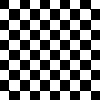
Fig. 2 - A 10 x 10 dot image with alternating black and white dots - enlarged so that each dot is represented by a 10-by-10-pixel square.
Large digital images contain so many dots that the images cannot fit on a computer screen; there are more dots than the screen contains pixels. For instance, an image from a good digital camera might have 2000 x 3000 dots, but Apple's enormous $3,000, 30-inch display has only 2560 x 1600 pixels. A more typical display might have 1024 x 768 pixels, and high-resolution displays may reach resolutions of 1200 x 1600. Thus, many digital images must be displayed by graphics programs at reduced resolution to fit on screen; the programs reduce the resolution for display according to algorithms created by the program designers.2 To repeat, large digital images cannot be displayed in their entirety on screen at their maximum size and resolution. At maximum resolution only a portion of the image can be seen; if the whole image is visible, the resolution will be reduced automatically by the graphics program. So how does one compare the quality of large digital images?
Comparing images on the Web is made more difficult still by virtue of the fact that Web browsers do not accept images for display in the most faithful formats, requiring instead that images be in a compressed format to be displayed by a browser. The most-used compressed format for good color photos is the JPEG format, which discards some color information in order to make the image file smaller. So, at the least, any Web image is inferior to the original, if only slightly so.
Large, high-resolution computer images on a Web page cannot be displayed in their entirety at full resolution and at full size; the limits discussed above apply to Web images as well as images on a local computer. Furthermore, Web software does not generally permit images to be enlarged or reduced;3 so images intended for display on the Web are normally reduced in resolution to fit on their pages and are displayed with one pixel per dot. In addition, as mentioned, image files used on the Web are inferior, if only slightly, to the originals. Thus, Web images lack both the resolution and the color fidelity of good, large digital images. So, I ask with slight modification, how does one compare the quality of large digital images on the Web?4
There is no simple, direct way to make comparisons of image quality on the Web. One would ideally want to examine images by looking carefully at the best, uncompressed versions of the whole images and by comparing images at various sizes and resolutions, but that is not possible on the Web. Instead, one must make a variety of comparisons, assuming that an overall sense of superiority will emerge from the whole. All those comparisons must involve images other than the full, uncompressed originals -- derivative, secondary images made from the originals.
Creating relatively small secondary images that can be seen in a browser provides a reasonable, if awkward, set of comparisons adding up to an overall comparison. Therefore, I have created a variety of images from the originals that are meant to be comparable. However, making comparable images is more complicated than it may seem. If two original images are of the same or nearly the same resolution, it is easy -- and fair -- to crop them so that each shows on screen at full resolution (one pixel on screen per dot in the image file), use the same compression process, and display them side-by-side for comparison. But what is fair when comparing two images that are vastly different in terms of original resolution? Is it reasonable to crop each to the same area, compress them, and display them for comparison at full resolution -- even if that means one of the images is twice the size of the other?
This problem
of making fair, useful, and effective comparisons severely complicates the presentation of the images from the scanning test. Which secondary images should be made for comparison? How can images of vastly different starting resolutions be compared correctly? There are no certain answers; so I will try to define the processes carefully. The reader, in turn, must make the final judgments with the limits of the processes in mind.The slide used in the previous experiment was scanned with the new scanner. The default settings were used, but Digital ICETM was also used. (Digital ICE is the name for a set of scanning procedures that enable the machine to eliminate, completely or nearly so, the scratches, lint, dirt, and finger prints that may exist on a slide.) The slide was well cleaned with air and a brush before scanning.
The new scanner scans slides to very high resolution -- 5400 d.p.i. (7128 pixels x 4816 for the full image plus some of the mount) at its highest setting for 35 mm. slides. That compares to a resolution of 3072 x 4816 for the Luna Imaging scans (with none of the mount included). As a result, some adjustments were necessary to make effective comparisons between the results of the scanner and the results from Luna Imaging.
The scans were loaded into PhotoShop, and the auto-level command was given so that software-determined adjustments of brightness, contrast, and color balance could be applied; the Luna Imaging images used for comparison had been adjusted in PhotoShop in the same way. The scans were also cropped to remove all traces of the slide mount. Derivative images were then created for comparison with those used in the previous experiment, all of which were JPEG-compressed images. To try to make the derivatives roughly comparable, the following procedures were followed.
As a result of these processes, there are multiple comparisons of derivative images to be made. Readers may find the array of images bewildering, but carefully examining them all should be rewarding. The three versions of the entire image may first be compared:
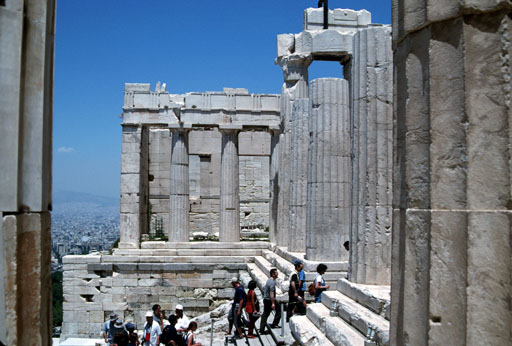 |
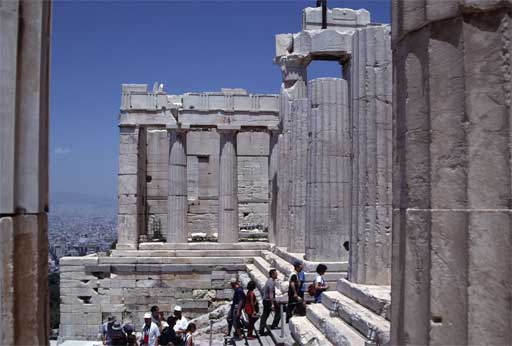 |
Luna Imaging full-slide image, after auto-level command in PhotoShop and reduction by one-sixth (linear measure). |
Scanned full-slide image, after auto-level command in PhotoShop, reduction to size of Luna imaging scan, and reduction by one-sixth (linear measure). |
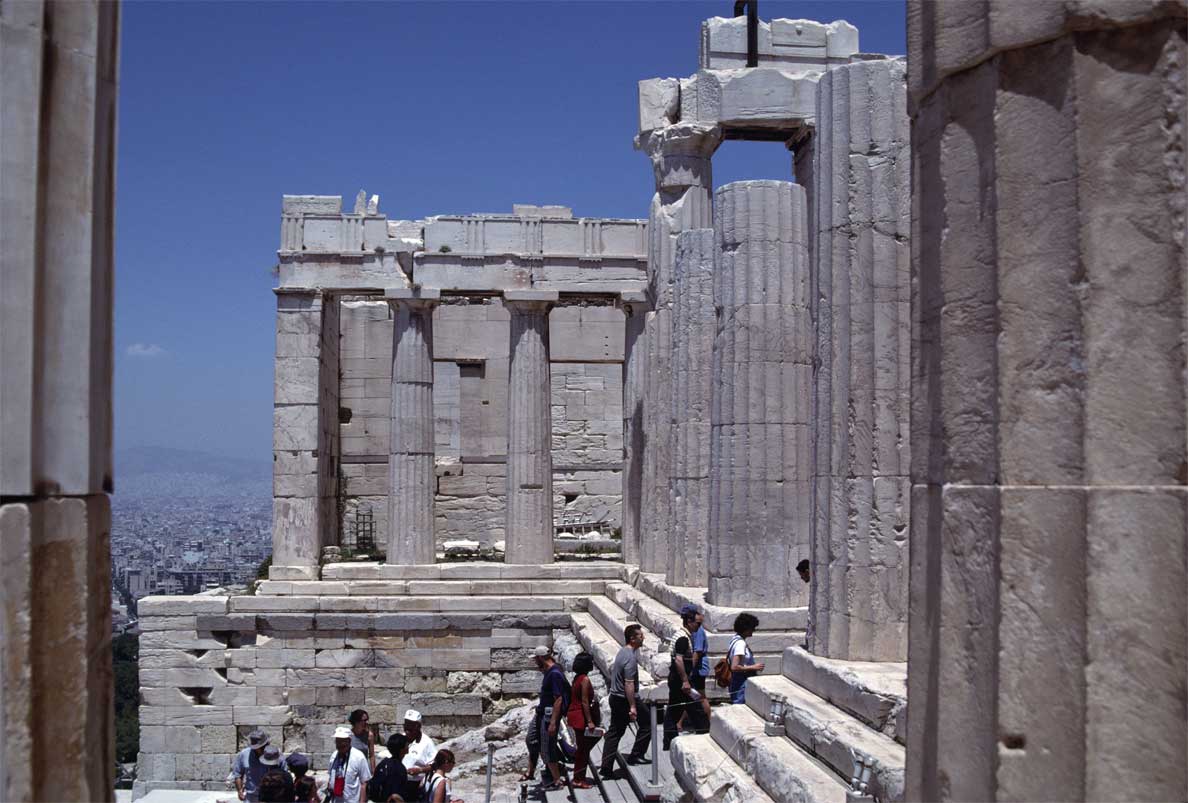
Fig. 5 - Entire Image, Version 3
Scanned image, after auto-level command in PhotoShop and reduction by one-sixth (linear measure).
The larger scanned image seems to me to be better than the Luna Imaging image by virtue of the fact that more detail is available. The reduced-size version of the scanned image seems less desirable, but, to my eye, the difference is in brightness and contrast, which are easily adjusted, not sharpness. I believe it could easily be made the equal of the Luna Imaging version with PhotoShop adjustments. (But, of course, it is possible that the Luna Imaging version could be further improved with PhotoShop.) Three versions of the detail of the frieze may also be compared:
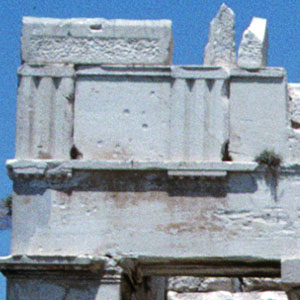 |
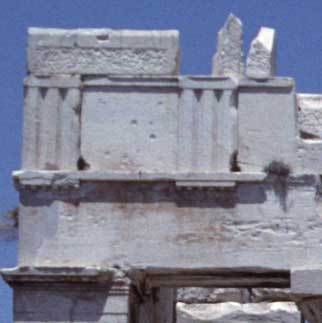 |
Luna Imaging detail, after auto-level command in PhotoShop, at one-pixel-per-dot resolution. |
Scanned image detail, after auto-level command in PhotoShop, at one-pixel-per-dot resolution after reduction to size of Luna imaging scan. |
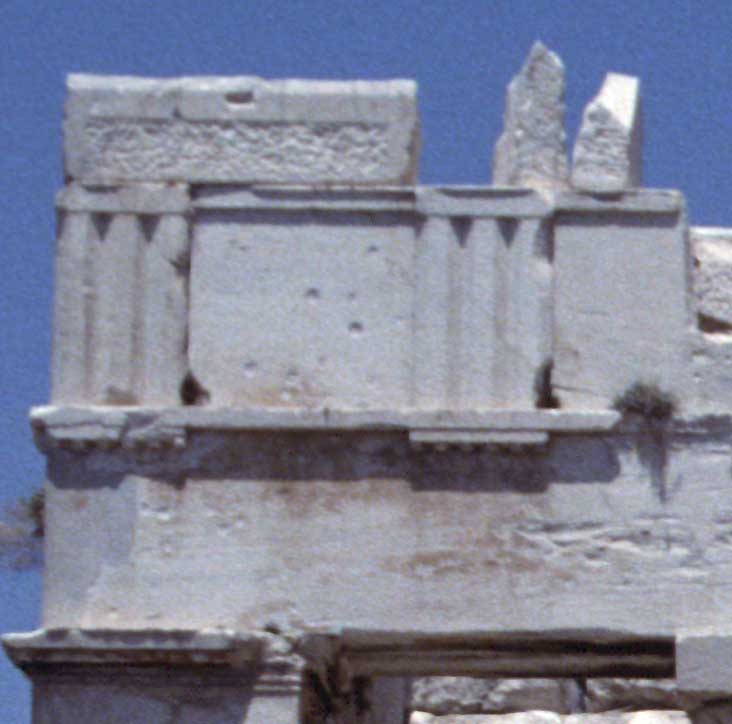
Fig 8 - Frieze Detail, Version 3
Scanned image detail, after auto-level command
in PhotoShop, at one-pixel-per-dot resolution.
The larger scanned image in this case seems a bit soft to me. However, there also seems to be more available information in the image. The reduced-size version compares well to the Luna Imaging image, but, as in the case of the overall image, it could be somewhat lighter and more contrasty. There are three versions of the detail of the base of the column to provide the final comparisons.
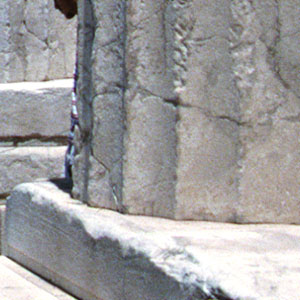 |
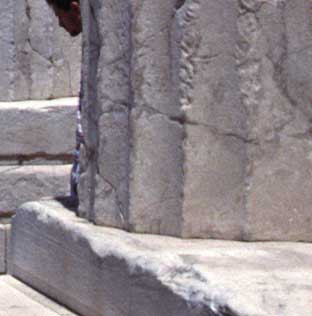 |
| Luna Imaging detail, after auto-level command in PhotoShop, at one-pixel-per-dot resolution. |
Scanned image detail, after auto-level command in PhotoShop, at one-pixel-per-dot resolution after reduction to size of Luna imaging scan. |
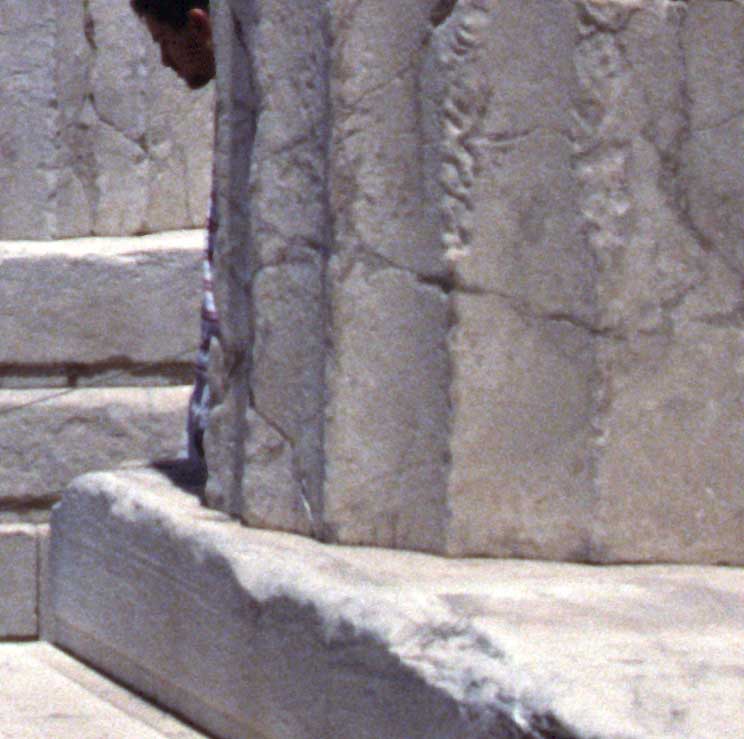
Fig. 11 - Column Detail, Version 3
Scanned detail, after auto-level command
in PhotoShop, at one-pixel-per-dot resolution.
The results here strongly favor the scanned image. The larger image retains considerable additional detail, and even the smaller scanned image seems the equal of the Luna Imaging image, though it seems to need to be lightened and to have its contrast raised.
There is a slight color cast on the images scanned here at the CSA offices. That could be changed, of course, in PhotoShop or some other image editing program, and it is not certain that the color of the scanned image is wrong, only that it is different. The more important issue, because it cannot easily be changed by later adjustments, is available detail. The higher-resolution scan seems to preserve significant detail and to be preferable to the Luna Imaging scans. The reduced-resolution versions, on the other hand, seem slightly less crisp to my eye. Brightness and contrast adjustments, simple ones made in PhotoShop, should make these images the equals of the Luna Imaging ones.
At the conclusion of this experiment, I realized that the results suggested an additional test: scanning the slide at lower resolution. Even at half its maximum resolution the scanner produces slightly higher resolution than was provided by Luna Imaging. So another scan of the test slide was made, this time at 2700 d.p.i. (3960 pixels x 2664 for the slide and a portion of the mount). As before, derivative images were produced for comparison purposes.
The second set of comparisons follows, beginning with the full image at reduced resolution. There are two version of the full image.
 |
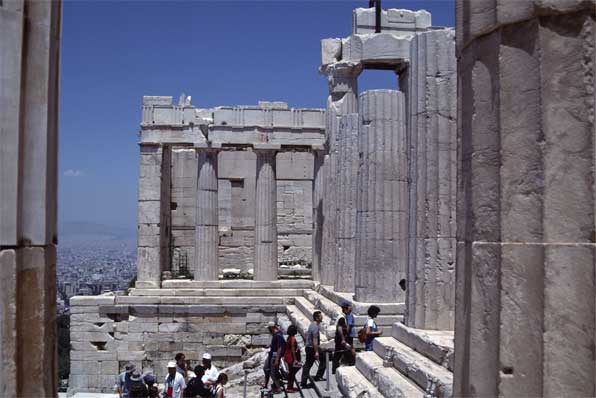 |
Luna Imaging full-slide image, after auto-level command in PhotoShop and reduction by one-sixth (linear measure). |
2700 D.P.I. image, after auto-level command in PhotoShop and reduction by one-sixth (linear measure). |
The Luna Imaging image seems to be brighter and a bit more contrasty, but it does not seem sharper. The details of the frieze and column may also be compared.
 |
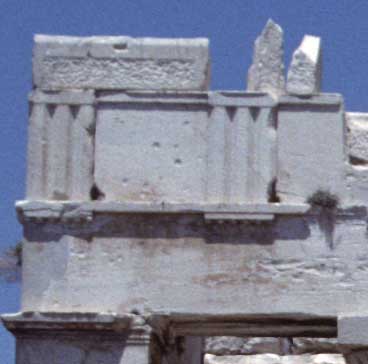 |
Luna Imaging detail, after auto-level command in PhotoShop, at one-pixel-per-dot resolution. |
2700 D.P.I. image detail, after auto-level command in PhotoShop, at one-pixel-per-dot resolution. |
 |
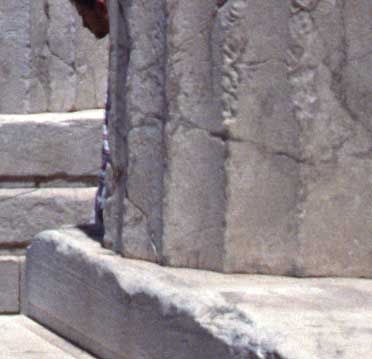 |
| Luna Imaging detail, after auto-level command in PhotoShop, at one-pixel-per-dot resolution. |
2700 D.P.I. detail, after auto-level command in PhotoShop, at one-pixel-per-dot resolution. |
To my eye the frieze detail from the scanner seems a bit soft, but the column detail seems better than the Luna Imaging version. One last comparison therefore seems to be required. The frieze details from the scanner -- the large one and the two smaller ones -- were re-made from the original scans and enhanced in PhotoShop by increasing contrast and brightness, using my eye as the arbiter. This is an inherently unscientific process, but it provides one final set of images to compare.
 |
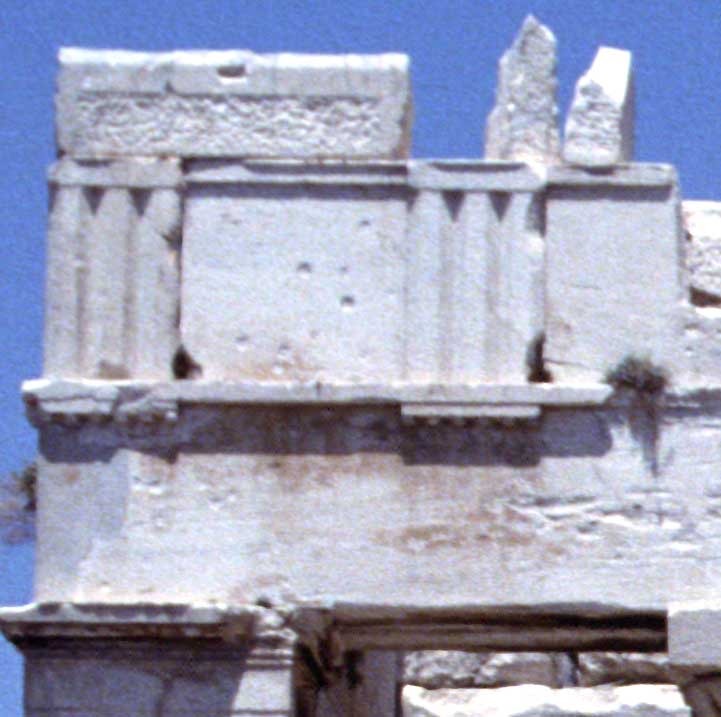 |
Luna Imaging detail, after auto-level command in PhotoShop, at one-pixel-per-dot resolution. |
High-resolution detail, after auto-level command in PhotoShop and adjustment to increase brightness and contrast. |
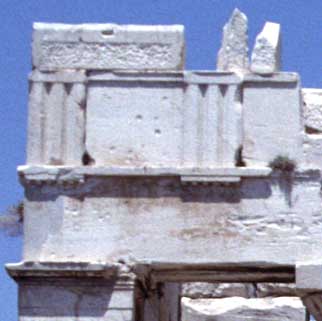 |
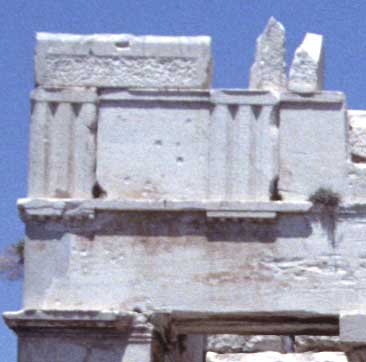 |
High-resolution detail, after reduction to Luna Imaging size, auto-level command in PhotoShop and adjustment to increase brightness and contrast. |
2700 D.P.I. detail, after auto-level command in PhotoShop and adjustment to increase brightness and contrast. |
Now the comparisons are very difficult. To my eye, the larger, high-resolution scan does contain more detail than the Luna Imaging image, though it seems softer. The reduced-size version of that scan seems almost identical to the Luna Imaging image. The lower-resolution scan seems slightly inferior to both the reduced version of the high-resolution scan and the Luna Imaging image. Given the march of technology, I assume scanners will continue to improve, but the results here are good.
Although I had once thought using a vendor to scan 35 mm. slides would remain necessary more or less indefinitely, that no longer seems to be the case, and I am happy to recommend the Konica Minolta DiMAGE Scan Elite 5400 II to others. Prices seem to range from about $525 to about $625. (One negative. The scanner and its software exhibited some recalcitrance when obliged to play nicely with CSA's MAC. Everything worked, but not always on the first try. It seems that the scanner software must be running for the initialization process to complete on the scanner.) The potential of scanning the slides of the ancient world taken over the years by scholars and placing those images on the Internet for wide access now seems much greater.
-- Harrison Eiteljorg, II
To send comments or questions to the author, please see our email contacts page.
1. CSA is indebted to Frank Abruzzese of the Camera Shop in Bryn Mawr, PA, for undertaking the initial experiment without charge. That experiment provided the initial proof that scanner technology had indeed come of age and led to CSA's purchase. Return to text.
2. Printers use much smaller dots than the pixels on a screen; so good digital images need to have many more pixels than will be displayed on screen. Return to text.
3. Modern browsers sometimes can re-size an image to fit, but the user has little or no control over the processes. Otherwise, zooming in on a Web image requires special software. Return to text.
4. Even limited comparisons such as those offered here only compare digital images to one another. The true test would be a projection of a slide next to a projection of a digital image made from the slide. Return to text.
For other Newsletter articles concerning the use of electronic media in the humanities, consult the Subject index.
Table of Contents for the Spring, 2005 issue of the CSA Newsletter (Vol. XVIII, no. 1)
 Table of Contents for all CSA Newsletter issues on the Web
Table of Contents for all CSA Newsletter issues on the Web
| CSA Home Page |